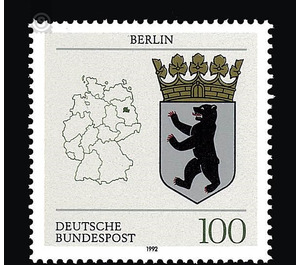Coat of arms of the Land of the Federal Republic of Germany (1) - Germany / Federal Republic of Germany 1992 - 100 Pfennig
Theme: Art & Culture
| Country | Germany / Federal Republic of Germany |
| Issue Date | 1992 |
| Face Value | 100.00 |
| Color | multi-colored white |
| Perforation | K 13 3/4 |
| Printing Type | Multicolor offset printing |
| Stamp Type | Postage stamp |
| Item Type | Stamp |
| Chronological Issue Number | 1461 |
| Chronological Chapter | GER-BRD |
| SID | 529690 |
| In 51 Wishlists | |
The upright walking bear is the world-famous heraldic animal of Berlin. Since an actual Berlin charter does not exist, it is not possible to make any assurances about where the bear comes from as a Berlin seal or heraldic animal. Noteworthy is the number of theories; One would like to contact him with Albrecht the Bear, the most famous of the Ascanians, another to establish a relationship with the place name Berlin. Yet another sees the bear as a predator dominating our forests at that time. The oldest known seal with the bear figure comes from the year 1280. It shows two bears as mutual shield holder of the Brandenburg eagle with helmet and helmet ornament. It bears the Latin inscription: "Sigillum Burgensium de Berlin sum" - I am the seal of the citizens of Berlin. This seal is today referred to as the precursor of the Berlin coat of arms. The city seal of 1280 and its later coats of arms were thereafter always an expression of the city-political situation; the heraldic bear - in whatever shape - became the hallmark of this city. A document of the Berlin Council from the year 1338 shows for the first time the bear in the middle of the seal medallion. At the neck of the bear there is a ribbon dragging a shield with the Brandenburg eagle behind it like a dragon. This so-called secret seal can also be found on the deed of subjugation of the year 1448, when the uproar of the citizens of Berlin against the Hohenzollern was crushed. These had been lent in 1410 with the Mark Brandenburg. The Berlin Turmoil was at the same time the end of a bourgeois independence; From then on, the city became the residence of the Hohenzollerns. The changed political situation found its expression in a new seal; it shows the sovereign eagle, clinging to the back of the bear striding on all fours, as it were riding, and as it were an expression of the subjugation of the city under the rule of the elector of the Hohenzollerns. This seal was valid until 1700, it was used - slightly modified - until 1709. On February 6, 1710, a new coat of arms and seal was ordered for Berlin. It is a shield divided into three white fields; the two upper ones show the black Prussian and the red Brandenburg eagle. In the lower field, the bear walks upright, wearing a collar. Above the shield, framed by deciduous ornaments, is the "Souveraine Churhut," the crown of the Prussian kingdom that has risen from the Electorate. In 1839 this coat of arms was modified; instead of the crown of the Hohenzollern above the bear's shield a mural crown appears; thus it is also characterized as a city seal. Even after the abolition of the monarchy in Germany in 1918, the bear prevailed as the only coat of arms; the dynastic emblems such as the Prussian and the Brandenburg eagle had become superfluous. Since 1945, the history of the coat of arms figure must be seen concretely against the backdrop of political developments in Berlin. After the final division of the city in 1948, there were almost logically two different coats of arms. Although the bear still formed the common heraldic animal, but the patterns of the bear coat of arms differed in Berlin (West) and Berlin (East). Articles 1 and 5 of the Constitution of 1950, valid only in the western part of the city, made a new conception of the Berlin coat of arms necessary, since Berlin became both city and country at the same time. In the law on the emblems of the country Berlin of 13 May 1954 the coat of arms is described as follows: »The national coat of arms shows in silver (white) shields a raised black bear with red tongue and red claws. On the shield rests a golden five-leafed deciduous crown, whose masonry forehead is equipped with a gate in the middle. " This coat of arms is valid until today. In East Berlin, the coat of arms in silver showed a black bear with red tongue and reinforcement. Above it was a five-towered red masonry crown. With the establishment of the legal entity of the city on October 3, 1990, the law of the province was "extended" to the eastern part of the city. Thus applies from this time on the previous West Berlin coat of arms for all of Berlin. (Text: Senate Department for Home Affairs, Berlin)


